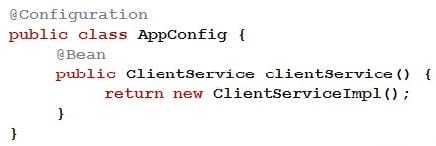2V0-72.22 Online Practice Questions and Answers
Which two options are REST principles? (Choose two.)
A. RESTful applications use a stateless architecture.
B. RESTful application use HTTP headers and status codes as a contract with the clients.
C. RESTful applications cannot use caching.
D. RESTful application servers keep track of the client state.
E. RESTful applications favor tight coupling between the clients and the servers.
Which two statements are true regarding a Spring Boot-based Spring MVC application? (Choose two.)
A. The default embedded servlet container can be replaced with Undertow.
B. Jetty is the default servlet container.
C. Spring Boot starts up an embedded servlet container by default.
D. The default port of the embedded servlet container is 8088.
E. Spring MVC starts up an in-memory database by default.
Which two are required to use transactions in Spring? (Choose two.)
A. Add @EnableTransactionManagement to a Java configuration class.
B. Annotate a class, an interface, or individual methods requiring a transaction with the @Transactional annotation.
C. A class must be annotated with @Service and @Transaction.
D. A class requiring a transaction must implement the TransactionInterceptor interface.
E. Write a Spring AOP advice to implement transactional behavior.
Which two statements are true regarding the RestTemplate class? (Choose two.)
A. It supports asynchronous non-blocking model.
B. It automatically supports sending and receiving Java objects.
C. It provides convenience methods for writing REST clients.
D. It provides convenience methods for writing REST services.
E. Sending an HTTP request with a custom header is not possible when using RestTemplate.
Spring Boot will find and load property files in which of the following? (Choose the best answer.)
A. A *.properties file matching the name of the class annotated with @SpringBootApplication.
B. config.properties or config.yml, usually located in the classpath root.
C. application.properties or application.yml, usually located in the classpath root.
D. env.properties or env.yml, usually located in the classpath root.
Which three statements are advantages of using Spring's Dependency Injection? (Choose three.)
A. Dependency injection can make code easier to trace because it couples behavior with construction.
B. Dependency injection reduces the start-up time of an application.
C. Dependencies between application components can be managed external to the components.
D. Configuration can be externalized and centralized in a small set of files.
E. Dependency injection creates tight coupling between components.
F. Dependency injection facilitates loose coupling between components.
Which two statements about pointcut expressions are true? (Choose two.)
A. A pointcut expression cannot specify the type of parameters.
B. A pointcut expression will throw an exception if no methods are matched.
C. A pointcut expression cannot have a wildcard for a method name.
D. A pointcut expression can include operators such as the following: andand (and), || (or), ! (not).
E. A pointcut expression can be used to select join points which have been annotated with a specific annotation.
Refer to the exhibit.

What is the id/name of the declared bean in this Java configuration class? (Choose the best answer.)
A. clientServiceImpl (starting with lowercase "c")
B. clientServiceImpl (starting with uppercase "C")
C. clientService (starting with lowercase "c")
D. ClientService (starting with uppercase "C")
Which statement about @TestPropertySource annotation is true? (Choose the best answer.)
A. Java system properties have higher precedence than the properties loaded from @TestPropertySource.
B. Properties defined @PropertySource are not loaded if @TestPropertySource is used.
C. @TestPropertySource annotation loads a properties file relative to the root of the project by default.
D. Inlined properties defined in @TestPropertySource can be used to override properties defined in property files.
Which two statements are correct regarding the Health Indicator status? (Choose two.)
A. The last status in a sorted list of HealthIndicators is used to derive the final system health.
B. The status with the least severity is used as the top-level status.
C. Custom status values can be created.
D. The built-in status values are DOWN, OUT_OF_SERVICE, UNKNOWN, and UP in decreasing order of severity.
E. The severity order cannot be changed due to security reasons.
What two options are auto-configured Spring Boot Actuator HealthIndicators? (Choose two.)
A. DataSourceHealthIndicator
B. GoogleCloudDataStoreHealthIndicator
C. DynamoDBHealthIndicator
D. RabbitHealthIndicator
E. OktaHealthIndicator
Which two annotations indicate that the transaction for a transactional test method should be committed after the test method has completed? (Choose two.)
A. @SqlMergeMode(false)
B. @Rollback(false)
C. @Commit
D. @Sql(alwaysCommit=true)
E. @Transactional(commit=true)
Which two statements are true regarding bean creation? (Choose two.)
A. A Spring bean can be explicitly created by annotating methods or fields by @Autowired.
B. A Spring bean can be implicitly created by annotating the class with @Component and using the component-scanner to scan its package.
C. A Spring bean can be implicitly created by annotating the class with @Bean and using the component-scanner to scan its package.
D. A Spring bean can be explicitly created using @Bean annotated methods within a Spring configuration class.
E. A Spring bean can be explicitly created by annotating the class with @Autowired.
Which statement defines a pointcut? (Choose the best answer.)
A. A point in the execution of a program such as a method call or field assignment.
B. An expression that selects one or more join points.
C. A module that encapsulated advices.
D. Code to be executed at each selected join point.
Which following statements are true about Spring Data? (Choose two.)
A. Spring Data implementations exist for many data storage types, such as MongoDB, Neo4j, and Redis.
B. Spring Data works by applying the JPA annotations to data stores such as MongoDB, Neo4j, and Redis.
C. Spring Data can greatly reduce the amount of "boilerplate" code typically needed for data access.
D. Spring Data is specifically designed for JPA, JDBC, and relational database access only.
E. Spring Data cannot be used together with Spring MVC.
